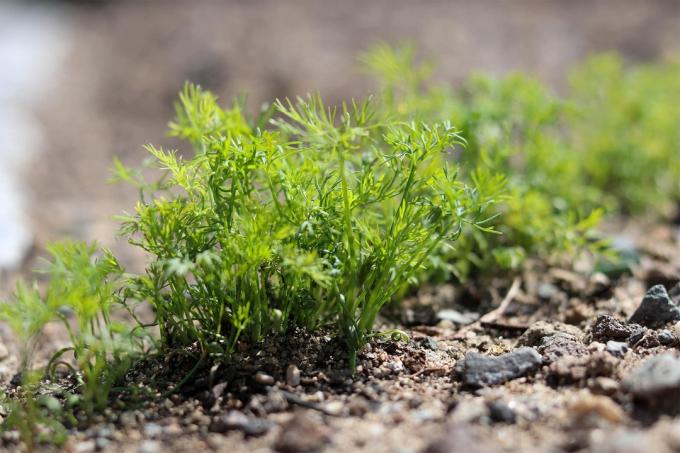
Dill is undemanding and very easy to care for. However, the right soil and location is an important prerequisite for good growth and high crop yields. Everything you need to know about this below.
In a nutshell
- loves a sunny location
- humus and nutrient-rich soil desired
- feels good in a mixed culture with cucumbers, lettuce and beets
- Avoid waterlogging
- thrives in moist, medium-heavy soil
Table of contents
- location dill
- floor requirements
- frequently asked Questions
location dill
The annual dill (Anethum graveolens), also known as cucumber herb, can be grown in the garden in a bed or in a pot of appropriate height on the terrace. The site is the same for both variants. The umbellifer has the following requirements:
- Sun to semi-shade
- sheltered place

The herb is best in a sunny place. Here it grows particularly well, at the same time the formation of the essential oils in the herb is promoted and there are many insects to pollinate. Dill also thrives in partial shade, but growth and crop yields are lower. A sheltered place, especially from the wind, should be chosen to prevent the seed from being blown away and the associated self-sowing. Dill can also be grown in mixed cultures. he feels particularly comfortable between:
- salad
- cabbage
- beets
- cucumbers
When sowing dill next to parsnips and carrots, it promotes the aroma and also the germination of the root vegetables. The herb does not like to stand on the other hand next to:
- Caraway seeds
- tarragon
- chamomile
- peppermint
- fennel
If these plants are in the immediate vicinity of dill, pollination occurs among themselves. The result would be weaker, more vulnerable plants and lower yields.
A notice:You should not sow dill in the same spot every year to prevent diseases such as Fusarium wilt. A break in cultivation of four years is advisable.
floor requirements
Next to choosing the right location the soil is also important for the dill. The weak feeder also thrives on poor soil. However, growth here is lower. Not just that Soil must be chosen well, but he must also be well prepared. Only then can good yields be expected. So, on compacted and heavy soil, dill will not grow, and the seed will not germinate. The floor should therefore have the following characteristics:
- rich in nutrients and humus
- permeable
- relaxed
- moderately dry to moderately moist
- slightly alkaline to neutral
- sandy to loamy

The cucumber herb thrives particularly well in medium-heavy and moist soil such as clay soil with a certain amount of gravel and sand. The water can drain well. There can be no waterlogging. Loosen heavy soil well before sowing and prepare it with sand or gravel.
A notice: Dill needs to be planted or seeded densely so that the lower stem areas of the plants are shaded. This protects you from drying out.
frequently asked Questions
It can be preferred, but young plants are sensitive to transplanting. Sowing directly into the bed is better. This can be done from April, when the night temperatures no longer fall below seven degrees. The seed can be spread or sown in rows. The row spacing must be 25 cm and the sowing depth up to 0.5 centimetres. Subsequent sowing can be done at intervals of two to three weeks until August.
The harvest can begin from a growth height of 15 cm. Young leaves and shoots are harvested regularly. The umbels should be cut when they begin to turn brown. In general, a harvest can take place from July to October. Dill stays fresh for up to three weeks in a screw-top jar in the fridge. In addition, the herb can also be frozen, cut into small pieces. Drying is also possible.
Dill does not make any special demands on care. Sufficient moisture is important, especially after sowing. Regular watering is therefore necessary. But be careful, waterlogging is to be avoided. Fertilization is normally not absolutely necessary. If you give too much fertilizer, the stems will become soft. Plant manure, for example comfrey stock, can only be administered from time to time to promote new shoots. It is important to regularly remove weeds and loosen the soil.



